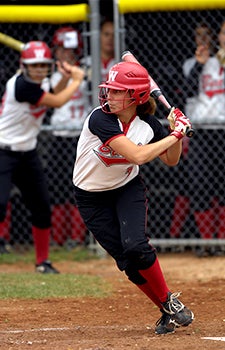
Chemist aims to build a better plastic bottle and help young scientists thrive
As a high school sophomore in St. Louis, Megan Fieser jumped at a chance to enroll in a course that offered real experience in university research lab. After three years, the high school senior knew that she wanted to be a chemistry professor.
But that’s not all she wanted. The budding scientist was also an athlete, fiercely committed to playing intercollegiate softball. While it was tough to juggle the demands of an undergraduate chemistry program at Washington University in St. Louis while logging 20-plus hours a week in training and practice, Fieser managed to excel at both.
“I have extreme tunnel vision,” she explained. “Once I set my mind to something, I’m determined to make it happen.”
Rare-earth answers
Fieser joined the USC Dornsife College of Letters, Arts and Sciences last fall as Gabilan Assistant Professor of Chemistry. She intends to focus on the world’s plastics pollution problem, finding ways to use rare-earth metal catalysts to create alternative materials to replace petroleum-based plastics. Only a few degradable plastics are on the market today, since many aren’t considered affordable enough for widespread adoption.
“The biggest obstacle is making these environmentally friendly materials at a competitive price compared to petroleum-based products,” she said.
Despite their name, rare-earth metals are not so rare, and they are used as components in things like strong magnets, batteries and cell phones.
Fieser’s second research focus is using metal catalysts to aid in the degradation of plastics such as polyethylene terephthalate (PET). Not easily degradable, PET is best known as the clear plastic used for water and soda bottle containers. Their accumulation on land and sea is widely considered a global environmental menace, with a decomposition timeline of about 450 years. An estimated 8 million metric tons of plastic are dumped in the world’s oceans each year.
Science and softball successes
Besides its renown in research, USC Dornsife drew Fieser for its focus on creating a supportive environment. “It was something I was really striving to find,” she said. “I felt like USC was a school that would help me pursue my vision of inspiring the next generation of independent scientists and to help them become their best selves as scientists.”

Megan Fieser bats in the Division III NCAA regionals in 2010 for Washington University at St. Louis, where she set a school record for most stolen bases and received the honor of Third Team All-American. (Photo: Courtesy of Megan Fieser.)
Although they are very different institutions, she sees culture similarities between USC and Washington University, where Fieser felt supported pursuing twin goals as an athlete and a scientist. During her freshman year in 2007, the Washington softball team took home the second-place trophy in the NCAA Division 3 College World Series championship. Fieser capped off the series with one of her best-ever games, in which she racked up eight RBIs including a homerun. During her senior year, she received a 3rd Team All-American Award in Division 3 as a shortstop.
And off the field, she enrolled in a program called FOCUS: Women in Science that proved to be a game changer. Featuring a semester of women’s studies and two semesters on women in science, the program was taught by female faculty who became her mentors, one a chemist and the other a women, gender and sexuality studies scholar.
“I think it created an awareness for what it might be like to be a woman in science,” Fieser said. “You have to get used to being the only woman in the room sometimes. I’ve never felt held back in my aspirations of being a woman in science, but I know that is not what every woman in science has experienced.”
Balancing act
As an undergraduate Fieser found essential tools to balance life as a chemist and as an athlete and a realization that problems are inevitable, but not insurmountable.
“Over time I realized that I needed the support system that could help me find the balance,” she said. “Being an athlete really helped me learn how to be a successful individual, and also a team player, which I think is useful in any lab.”
While interviewing for a position at USC Dornsife, Fieser impressed her future colleagues with her combined research acumen, dynamism and keen presentation skills, said Surya Prakash, George A. and Judith A. Olah Nobel Laureate Chair in Hydrocarbon Chemistry and professor of chemistry. Prakash chairs the Department of Chemistry. “She was hired for her outstanding research accomplishments, and she’s also a great role model for women in science and engineering.”
Attracting and retaining female scientists is a central goal to the Gabilan professorship, a recruitment tool within the Women in Science and Engineering program at USC.
Born in Long Beach, California, Fieser completed a postdoctoral appointment in mechanistic polymer chemistry at the University of Minnesota prior to joining USC Dornsife. She completed her Ph.D. in 2015 at the University of California, Irvine pursuing fundamental studies on the rare earth series of elements.